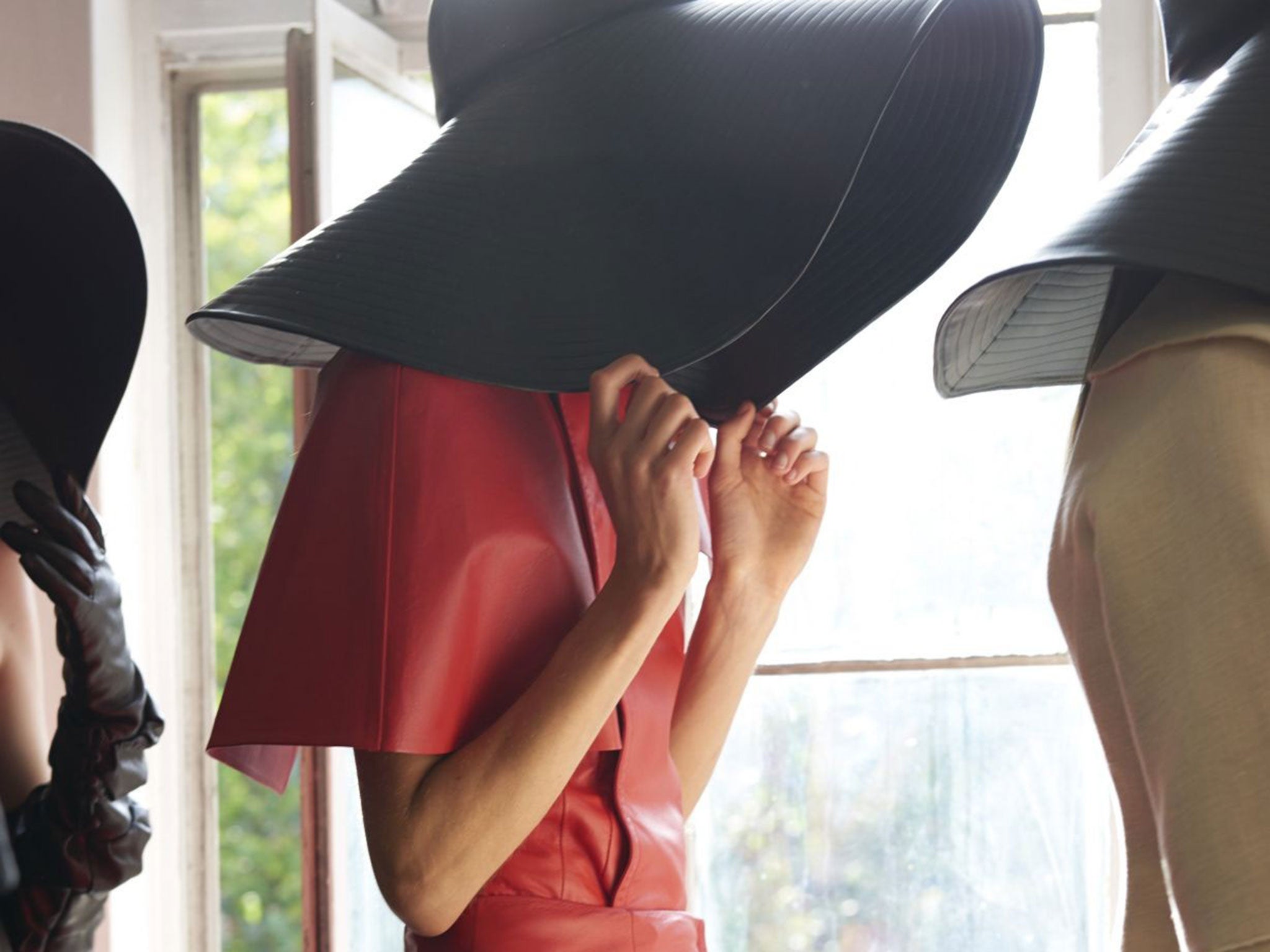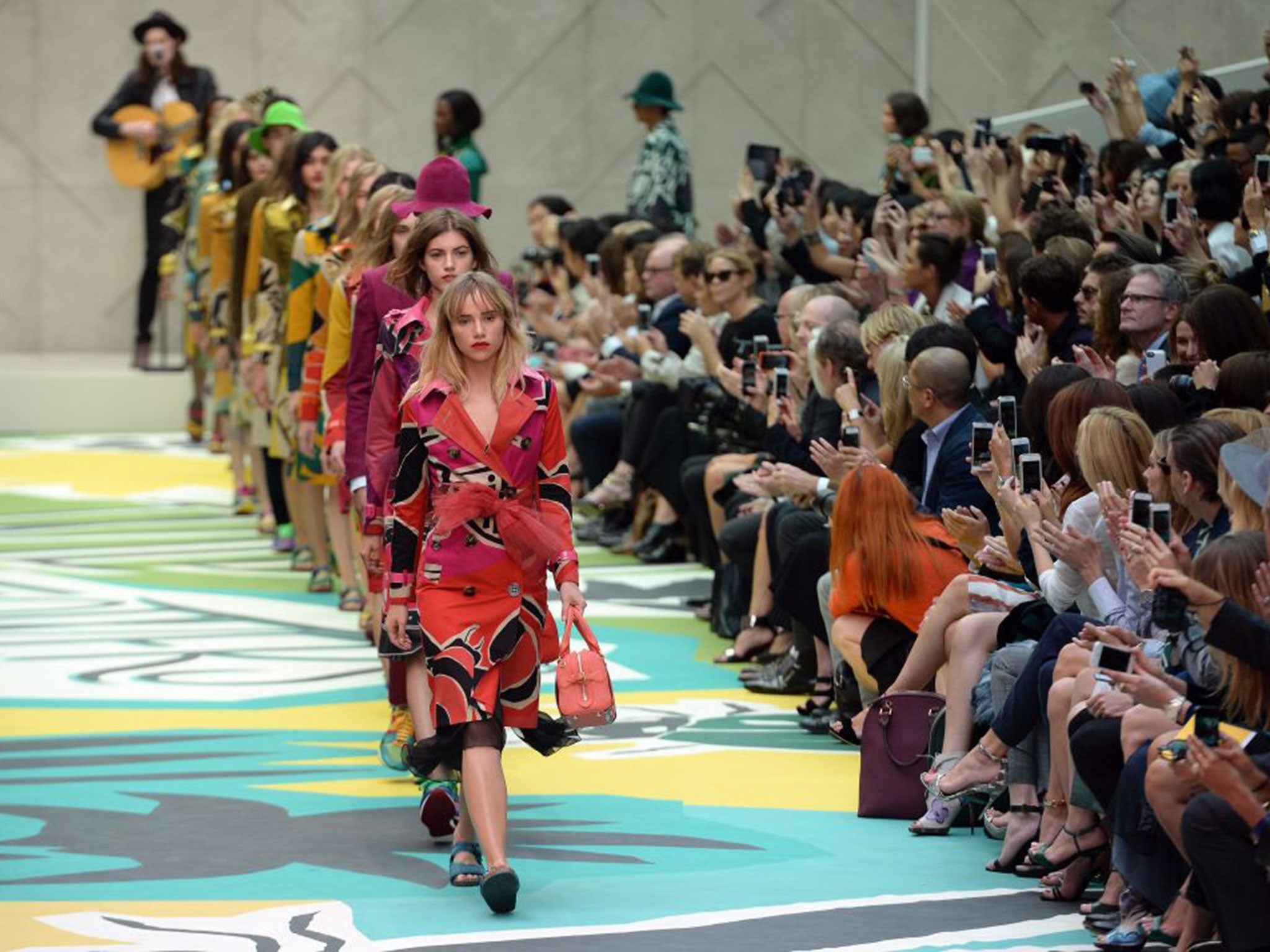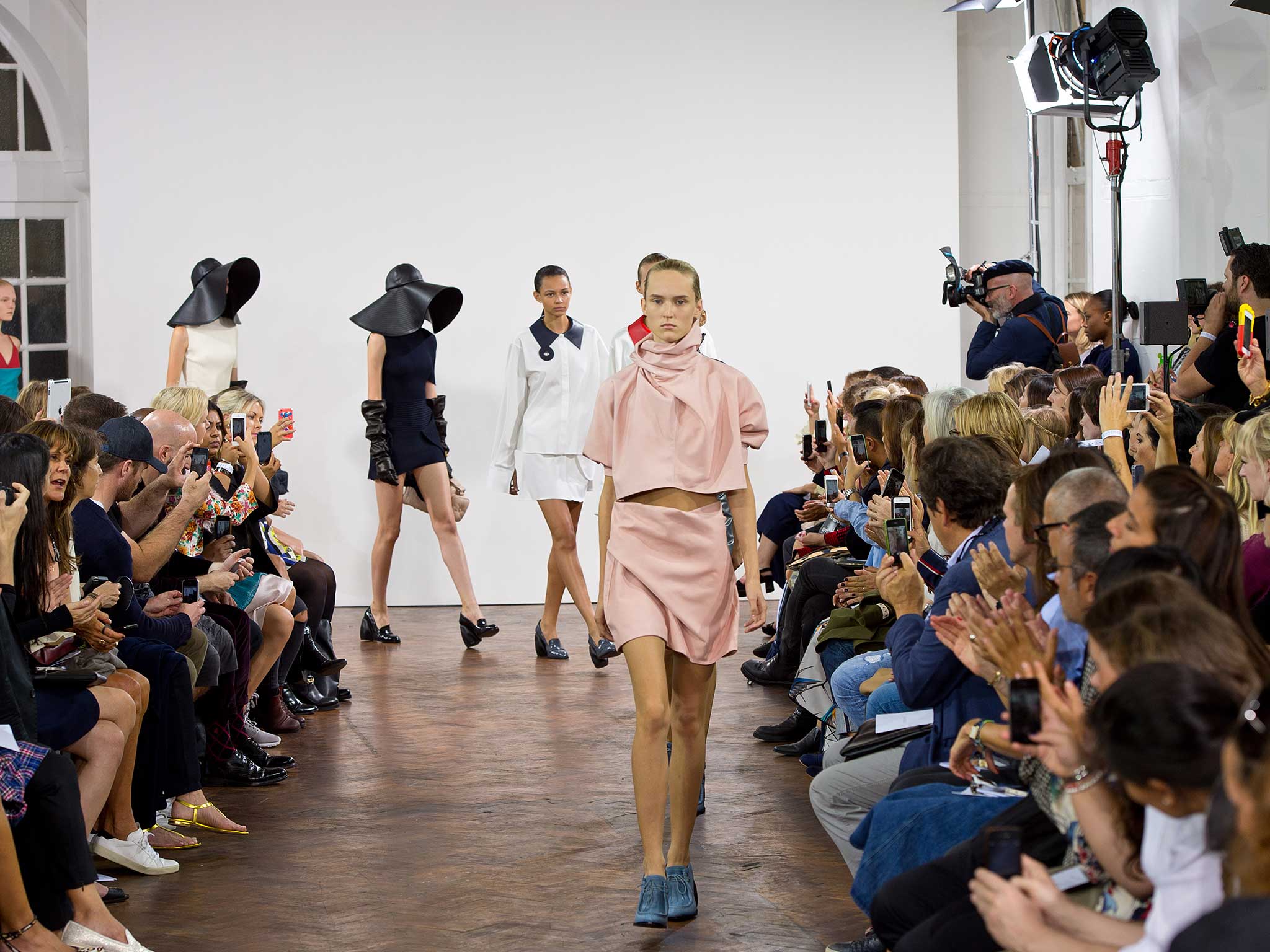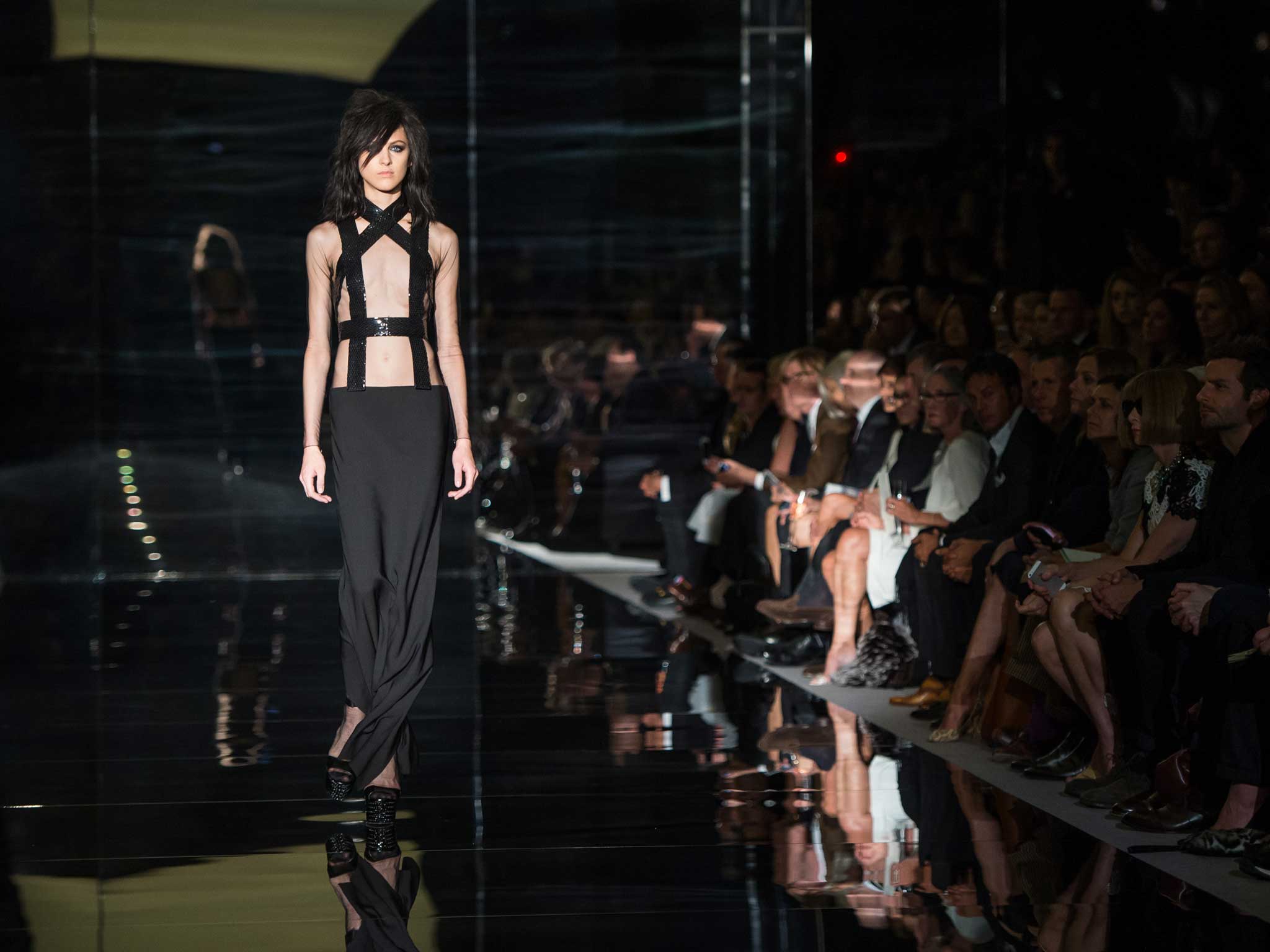From Topshop to Burberry, London Fashion Week spring/summer 2015: Distraction could not disguise a distinct lack of focus
From digital bells and whistles to carnivals on the catwalk, there was no shortage of entertainment at the spring/summer collections

Distraction. That was the keynote of spring/summer 2015’s London Fashion Week. The most extreme example was the workman who plunged through the roof of the Topshop show venue, in the midst of the Fashion East show. Many assumed the story was apocryphal, not least because the show continued regardless. That felt like a callous scene straight out of a fashion parody, or like Nero fiddling while Rome burned. The injured party is now doing fine, so it was an accident rather than a tragedy. Nevertheless, it was surprising how easily it distracted even the hardened, hard-nosed professionals from the shows on show. It was not, we can safely say, a vintage season.
Other distractions were varied and numerous: the slightly daft hats that topped every look at JW Anderson; the turntable catwalk at Anya Hindmarch, Wurlitzing the audience around her trademark bag shapes jazzed up with carnivalesque scribbles; or the looming screens at Hunter Original, bubbling away a pointless aquatic fantasia behind simple-minded, under-designed clothing. And there are always distractions at Burberry Prorsum: selling from live streams, saturation backstage coverage, and, invariably, tinnitus-inducing live music.
This season, the distraction was a partnership with YouTube that allowed online viewers to move through “dimensions of experience”. That didn’t impact on our view of the show, although elements seemed geared towards the World Wide Web rather than the fashion world (the decibel-level of that music, for one). Burberry’s former CEO, Angela Ahrendts, recently left to join Apple, and she probably had all the experience needed to join a tech company. You couldn’t help but wish that Burberry and its now chief executive and creative officer Christopher Bailey would focus more attention on innovation in the actual clothing, rather than on innovative and inventive means of publicising it.
Those kind of tech specs can help great clothes look even better, but they won’t save a clanger. If you rinse the clothes of the bells and whistles and they don’t stand up, then you have a problem. Sometimes, there’s not even that much going on. Jonathan Saunders showed his collection in a cavernous hall in the British Museum, but the clothes – often simple, too often simplistic – didn’t live up to the space around them. You left feeling empty.

There was a handful of collections, just, in London that didn’t rely on distractions, or that – even better – overcame them. Mary Katrantzou trucked in a ton of chipped rubber to cover her catwalk at the 11th hour. The red floor of her venue, a fire station in Lambeth, was too distracting, she said. The models wobbled, but none of them stumbled, which found a counterpart in the collection itself.
JW Anderson’s distractions were those hats – oversized, slouchy leather sou’ westers, which probably sounded like a good idea but came across as gimmicky, as well as recalling recent collections by Balenciaga, and Stefano Pilati for Yves Saint Laurent. The latter was more relevant than the former, because there was a bubbling undercurrent of the type of bourgeoise Belle de Jour perversion that the original Saint Laurent perfected. It was there in a trio of towelling Chanel-ish suits, the midriffs cropped out and suctioned to the body; in the marinere-buttoned flaps displaced from crotch to buttocks on sailor trousers; and always in the leather, grasping at waists, slithering against the body, sometimes sleekly seamed, sometimes chewed-up and clumped, like wadded bubblegum in an intestinal puce. That sounds like I didn’t like this show, perhaps, but I did.

There’s a strength and conviction to what Christopher Kane does. Even if you don’t like it, you can appreciate it, because you know it’s what he thinks is right. I didn’t like this collection, with it’s odd, off-colour palette. The wriggling, vermicious rope-patterned lace dresses that opened and closed the show had a compelling, repugnant appeal. That frisson of sickness was lacking in the rest, which got knotted up in odd experimentations in technique (satin cones, tulle insertions) that looked decidedly ropey. My main issue is conviction: I wasn’t convinced that he was convinced. But perhaps we demand too much from Kane, particularly when the season as a whole seems to be grasping around for meaning. We want Kane to make it all click, but you can’t be right all of the time.
Conviction was what made Tom Ford. Love it (as I do) or loathe it (as many others did), it was perhaps unparallelled in London when it came to ramming home its message. That message was leggy, short, sexy, simple. Sheer, sequins, sky-high hemlines, stilt-walker platforms and a slither of stocking-top. Simple, see? It didn’t have much to say, but what it said was fog-horned with such force, you were blown away. It was also unmistakably Tom Ford, emphasising and re-emphasising what he stands for in a cacophonous international marketplace. It blocked out all distractions. It minimised the noise.

Ford’s clothes were loud. That’s why they drowned everything else out. And regardless of personal taste, as an experience, that was great. Because – and here’s the rub – if the clothes are good enough, none of that background noise matters.
People get tied up in the idea of “commercial” clothing, and the precise interpretations of that. Pejoratively, it’s used to mean clothes rinsed of invention and experimentation. Clothes we’re familiar with – either from the designer showing them, or from other designers’ work. In actual fact, commercial fashion can (and should) be garments that are so beautiful, different and desirable, you’re simply compelled to buy them. No distractions needed.
Join our commenting forum
Join thought-provoking conversations, follow other Independent readers and see their replies
Comments